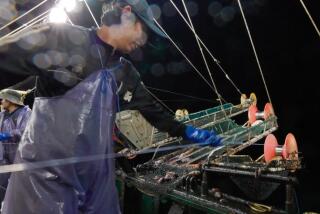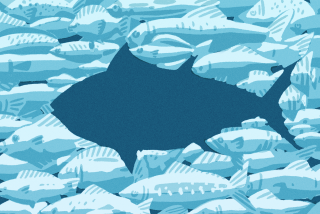Greenpeace Takes On Tuna
- Share via
Greenpeace, known internationally for its go-for-broke activism, docked its flagship, the Rainbow Warrior, in San Diego on Wednesday morning, thus beginning a four-day battle with the U.S. commercial tuna fleet over dolphin killing.
“Dolphin-safe tuna is a myth,” Greenpeace spokesman Bill Walker said after a pier-side news conference. “The U.S. government has set an international standard that allows up to 20,500 dolphin deaths per year. That’s not safe.”
A coalition of environmental groups maintains that the dolphin population in the Eastern Pacific has been depleted to dangerously low levels as a result of purse seine fishing, a technique that involves locating schools of deep-water fish and encircling them with a net. Schools of dolphins that customarily accompany the fish are used as indicators, and have been killed after becoming ensnared.
Coinciding with the Rainbow Warrior’s arrival, a coalition of environmental groups in Washington, D.C., submitted a petition to the U.S. State and Commerce departments to revoke the permit that allows the U.S. tuna industry to fish using purse seine nets. Greenpeace will attempt to raise support for the petition during its stay.
The U.S. tuna fleet is based in San Diego, two berths north of the Broadway Pier, where the Greenpeace schooner is docked.
In 1990, American tuna canners yielded to environmentalist demands to discontinue the use of purse seine nets. Three major sellers pledged to market only tuna caught without endangering dolphins. This led to a migration of 48 of the 54 vessels in the U.S. tuna fleet to the Western Pacific, where the native tuna species does not associate with dolphins.
Only six fleet boats remain in waters off San Diego, and fishers on those ships have adopted measures to protect the dolphin, said Bill Sardinha, a spokesman for Tuna Vessel Management, which oversees three of the local boats.
“Dolphin killing’s a dead issue around here. Most boats don’t fish off dolphin,” Sardinha said. “No canner in the U.S. is buying any tuna that’s related to dolphins. So why’s Greenpeace trying to stir the soup over this? They’re trying to make the public feel like it’s an urgent issue. Everyone loves dolphins, and you can betcha Greenpeace raises a lot of money off the dolphin cause.”
Sardinha said the few vessels still trolling dolphin-populated waters are monitored by on-board government officials. Nets must include a layer of finer netting that prevents dolphin snouts from becoming caught. The nets also must be lowered briefly before closing, which releases the dolphins. Each boat is staffed with divers who help the dolphins escape, Sardinha said.
In 1990, the number of dolphin deaths among the U.S. fleet was about 5,000. As a result of the safety precautions, the number dropped to 1,000 last year, according to national fisheries records, Sardinha said.
Richard Atchison, executive director of the American Tunaboat Assn., said the revocation of the general fishing permit would eliminate a means of livelihood for thousands.
“We’ve worked so hard at reducing the dolphin mortality rate,” Atchison said. “We think we should be rewarded instead of penalized. We need the permit to survive.”
Although there were only 1,000 deaths last year, “we cannot be sure the dolphin are really safe until there is a binding international agreement for a zero mortality rate,” Walker said. “And the U.S. should be the country leading the cause.”
The Rainbow Warrior will be open to the public Saturday, from noon until 5 p.m. It sets sail Sunday for Mexico’s tuna fleet base in Ensenada, after a one-day swing through Los Angeles.
More to Read
Sign up for Essential California
The most important California stories and recommendations in your inbox every morning.
You may occasionally receive promotional content from the Los Angeles Times.













